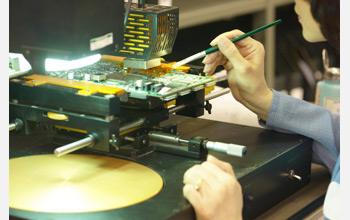News Release 10-113
U.S. R&D Companies Employed 27 Million Workers Worldwide in 2008
Stats show 7.1 percent of U.S. R&D company employees involved in R&D activities

In 2008, 1.9 million employees of U.S. R&D companies were engaged in R&D activities worldwide.
July 8, 2010
This material is available primarily for archival purposes. Telephone numbers or other contact information may be out of date; please see current contact information at media contacts.
U.S. R&D companies--companies located in the United States that performed or funded research and development (R&D) domestically or in their overseas locations--employed 27.1 million workers worldwide in 2008, according to a new National Science Foundation report.
The figures are the first employment statistics from the new Business R&D and Innovation Survey (BRDIS), developed jointly by NSF and the U.S. Census Bureau. Earlier this year, this same survey yielded information for the first time about worldwide sales and monetary amounts spent on R&D by U.S.-based companies. Data from that report can be found in an NSF press release and in an InfoBrief published in May.
Employment data from the BRDIS released today in a new NSF InfoBrief titled "New Employment Statistics from the 2008 Business R&D and Innovation Survey" show that R&D employees (those who perform or directly support R&D activities) accounted for 1.9 million jobs, or 7.1 percent of jobs at U.S. R&D companies worldwide. The domestic portion of total employment was 18.5 million workers, including 1.5 million R&D employees. Thus, domestic R&D employment accounted for 7.9 percent of companies' total domestic employment and for 77 percent of their worldwide R&D employment.
Policymakers and industry officials consider these numbers important because workers engaged in R&D activities directly influence the creation and diffusion of knowledge, and in turn contribute to innovation and economic growth. The proportion of R&D employment relative to total employment, or R&D employment intensity, is one indicator of a company's involvement in R&D activity.
Worldwide R&D employment intensity in some industries is much higher than the 7.1 percent figure for the aggregate of all industries; notably, R&D employment in scientific R&D services is at 31 percent; R&D employment associated with communications equipment is at 27 percent, and R&D employment associated with computer systems design and related services is at 25 percent.
In 2008, about 1.5 million, or 77 percent, of U.S.-based companies' 1.9 million worldwide R&D employees worked in the United States and 448,000, or 23 percent, worked at foreign locations of U.S. companies. Company-performed R&D per R&D employee (R&D expenditures divided by R&D employment) varied among domestic and foreign activities. For example, companies spent a total of about $181,000 on R&D per R&D employee worldwide, whereas the domestic and foreign figures were estimated to be about $194,000 and $140,000, respectively.
These statistics are preliminary; final and more detailed data will be available in early 2011. New measures from BRDIS related to R&D employment will be available in future publications and will include R&D employment by selected occupational category (engineers, scientists, technicians, and support staff); level of educational attainment (Ph.D. and other college degrees); and sex. The survey will also provide the number of non-U.S. citizens employed by industry as R&D scientists and engineers in the United States with temporary visas.
A third InfoBrief on business innovation, "R&D and Innovation in Business: 2008," will present additional, preliminary BRDIS data for 2008. It is being prepared, but not yet scheduled for publication. Detailed tables for 2008 will be available on the BRDIS Web page.
-NSF-
Media Contacts
Bobbie Mixon, NSF, (703) 292-8485, email: bmixon@nsf.gov
Program Contacts
Francisco A. Moris, NSF, (703) 292-4678, email: fmorisor@nsf.gov
The U.S. National Science Foundation propels the nation forward by advancing fundamental research in all fields of science and engineering. NSF supports research and people by providing facilities, instruments and funding to support their ingenuity and sustain the U.S. as a global leader in research and innovation. With a fiscal year 2023 budget of $9.5 billion, NSF funds reach all 50 states through grants to nearly 2,000 colleges, universities and institutions. Each year, NSF receives more than 40,000 competitive proposals and makes about 11,000 new awards. Those awards include support for cooperative research with industry, Arctic and Antarctic research and operations, and U.S. participation in international scientific efforts.
Connect with us online
NSF website: nsf.gov
NSF News: nsf.gov/news
For News Media: nsf.gov/news/newsroom
Statistics: nsf.gov/statistics/
Awards database: nsf.gov/awardsearch/
Follow us on social
Twitter: twitter.com/NSF
Facebook: facebook.com/US.NSF
Instagram: instagram.com/nsfgov


